Indoor herb garden kits let you cultivate fresh herbs right in your kitchen while creating a peaceful, therapeutic space. You'll need to choose between basic kits ($20-40) or premium options ($100-300+) based on your available space and commitment level. Most herbs require 6-8 hours of sunlight daily, though LED grow lights can supplement low-light areas. Start with easy-care varieties like basil, mint, and chives that forgive common beginner mistakes. With proper containers, quality soil, and basic tools, you'll enjoy fresh flavors year-round while reducing stress through gardening. Discover how these green companions can transform your living space.
Benefits of Indoor Herb Gardens
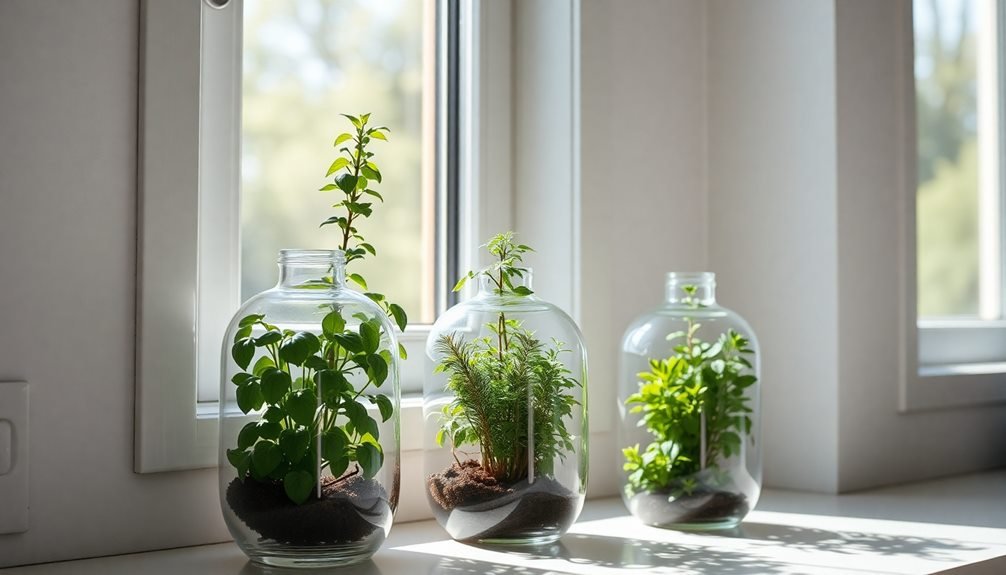
Growing fresh herbs indoors offers multiple rewards for both novice and experienced gardeners. You'll have immediate access to fresh, flavorful ingredients that can transform your cooking from ordinary to gourmet. Indoor herbs also cost considerably less than store-bought alternatives, saving you money while providing a continuous supply of fresh seasonings.
Your indoor herb garden will enhance your home's air quality by naturally filtering pollutants and releasing oxygen. You'll also benefit from the stress-reducing effects of tending to plants, as gardening has proven therapeutic benefits for mental health. The vibrant greenery adds natural beauty to your living space, creating an inviting atmosphere in your kitchen or windowsill.
You don't need to worry about seasonal changes or weather conditions affecting your herbs when they're grown indoors. You'll maintain complete control over growing conditions, ensuring your plants remain healthy year-round.
Additionally, indoor herbs are protected from outdoor pests and diseases, requiring fewer pesticides and resulting in healthier, organic produce. For busy households, these low-maintenance plants offer an ideal introduction to gardening while providing practical benefits for your cooking and well-being.
Choosing Your Perfect Starter Kit
When selecting your first indoor herb garden kit, you'll need to measure your available counter space and assess the natural light levels in your intended growing area.
While basic starter kits typically include simple containers and seeds, premium options offer built-in grow lights and self-watering systems that can overcome limited sunlight and space constraints.
You can start with an entry-level kit that fits your windowsill or invest in a countertop hydroponic system that provides everything needed for year-round growing.
Space and Light Requirements
Before selecting your indoor herb garden kit, you'll need to assess two essential factors: available space and lighting conditions in your home. Most herbs require 6-8 hours of direct sunlight daily, though some varieties can thrive with less. If you're short on natural light, consider kits that include LED grow lights.
| Space Type | Recommended Kit | Best Herbs |
|---|---|---|
| Windowsill | Narrow planter systems | Basil, Chives, Thyme |
| Countertop | Multi-tiered setups | Mint, Oregano, Sage |
| Wall-mounted | Vertical gardens | Parsley, Rosemary, Dill |
Your space requirements will vary based on the kit's design and the number of herbs you want to grow. A basic windowsill setup needs about 2-3 feet of linear space, while countertop models typically require a 1-square-foot footprint. Wall-mounted systems can save valuable counter space but need sturdy mounting surfaces and proper weight distribution. Remember to factor in growth space – most herbs need 4-6 inches between plants for proper air circulation and root development. You'll also want to keep your herbs away from heating vents and cold drafts that could affect their growth.
Basic Vs Premium Options
Indoor herb garden kits come in two distinct categories: basic starter kits ($20-40) and premium systems ($100-300+).
Basic kits typically include essential components: 3-5 seed packets, soil pellets or potting mix, plastic pots with drainage holes, and basic care instructions. These kits work well for beginners and those testing their green thumb without a major investment.
Premium systems offer advanced features that justify their higher price point. You'll find built-in LED grow lights, self-watering reservoirs, and smart sensors that monitor soil moisture, temperature, and nutrient levels.
Many premium kits connect to smartphone apps, sending notifications when your herbs need attention. They often include specialized growing mediums, premium seeds, and automated watering systems.
When choosing between basic and premium options, consider your gardening experience and commitment level. If you're new to indoor gardening, start with a basic kit to learn fundamental growing techniques.
If you're tech-savvy and want consistent results with minimal maintenance, a premium system might be worth the investment. Remember that both options can yield healthy herbs – success depends more on proper care than price point.
Essential Tools and Supplies
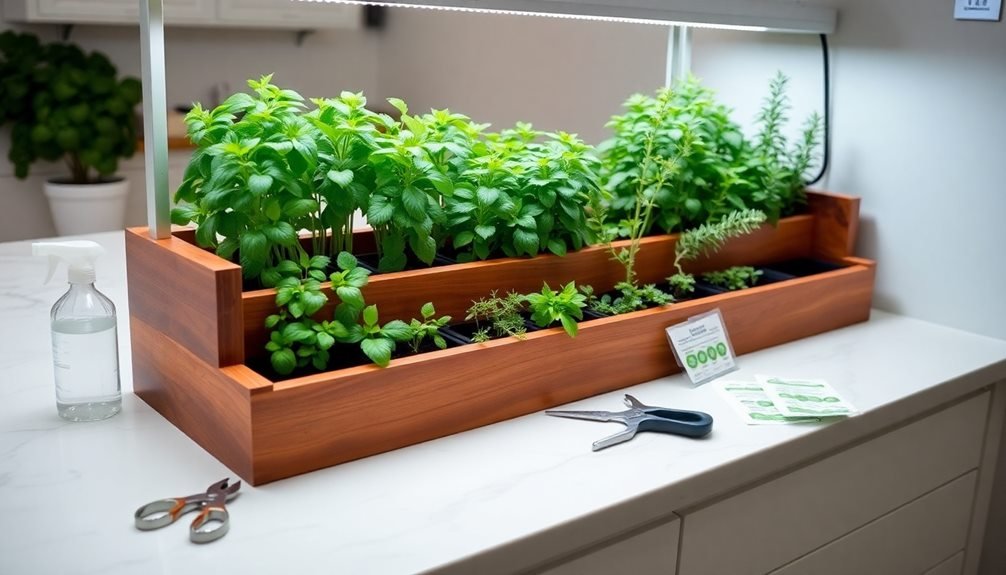
Four basic tools and supplies are essential for starting your indoor herb garden: containers with proper drainage, high-quality potting soil, basic gardening tools, and adequate lighting solutions.
Choose containers that have drainage holes and matching saucers to prevent root rot. You'll need 6-inch pots for most herbs, though larger varieties like rosemary require 8-inch containers. Select potting soil specifically formulated for herbs, as it provides the right balance of nutrients and drainage capabilities.
Your basic gardening toolkit should include pruning shears, a small trowel, and a watering can with a narrow spout for precise watering. Don't forget plant markers to identify your herbs and a spray bottle for misting. If you're growing from seeds, you'll also need a seed-starting kit with a humidity dome.
For lighting, you've got several options. South-facing windows provide ideal natural light, but if that's not available, you'll need grow lights.
LED grow lights are energy-efficient and don't generate excessive heat. Position them 6-12 inches above your plants and use a timer to maintain consistent light exposure of 6-8 hours daily.
Popular Herbs for Beginners
When you're starting your indoor herb garden, it's smart to begin with easy-care herbs like basil, mint, and chives that can tolerate some beginner mistakes.
These forgiving plants will help you build confidence while you learn the basics of indoor herb gardening.
Fast-growing options like cilantro, dill, and leaf lettuce can provide quick results, giving you harvestable herbs within just a few weeks of planting.
Easy Care Herbs First
Starting your indoor herb garden with easy-care varieties sets you up for success. These resilient herbs forgive common beginner mistakes and adapt well to indoor conditions, making them perfect for your first growing experience.
Focus on these low-maintenance herbs that'll thrive with minimal attention. They're forgiving if you occasionally forget to water them or provide slightly less than ideal light conditions.
| Herb | Care Level | Key Benefits |
|---|---|---|
| Basil | Very Easy | Fast growth, loves warmth, frequent harvesting encouraged |
| Mint | Easy | Vigorous growth, tolerates partial shade, pest-resistant |
| Chives | Very Easy | Drought-tolerant, grows back quickly, minimal space needed |
| Oregano | Easy | Disease-resistant, drought-tolerant, strong flavor even indoors |
You'll want to start with just 2-3 varieties to avoid feeling overwhelmed. Place them in a sunny windowsill where you'll see them daily – this reminds you to check their moisture levels and harvest regularly. Once you've mastered these easy-care herbs, you can gradually expand your indoor garden with more challenging varieties that require specific growing conditions.
Fast Growing Options
Building on your success with easy-care herbs, you'll love how quickly certain varieties can grow from seed to harvest. Fast-growing herbs can provide fresh flavors within weeks, making them perfect for impatient gardeners and quick kitchen needs.
Basil tops the list of speedy growers, reaching harvestable size in just 3-4 weeks. Plant sweet Genovese basil seeds, and you'll see sprouts within 5-7 days.
Cilantro grows equally fast, producing leafy stems in about 3-4 weeks, though it needs frequent reseeding as it bolts quickly.
Dill and mustard greens sprint to maturity in 20-25 days, while garden cress can be ready for your salads in just 10-15 days.
Mint varieties, particularly spearmint and peppermint, establish themselves rapidly and can overtake your indoor space if not contained properly.
For continuous harvests, try microgreens like arugula or radish tops, which you can snip within 7-14 days of planting.
These nutrient-dense options don't require deep pots and thrive under basic grow lights. Remember to succession plant every two weeks to maintain a steady supply of fresh herbs.
Light and Temperature Requirements
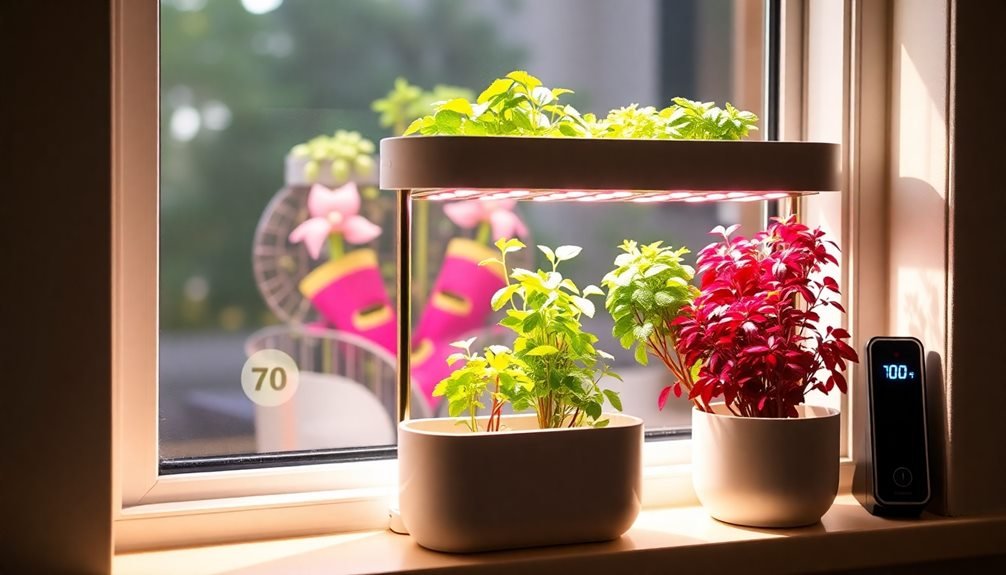
Most indoor herbs require 6-8 hours of daily sunlight and temperatures between 65-70°F (18-21°C) to thrive.
You'll need to place your herb garden kit near a south-facing window for ideal natural light exposure. If you don't have adequate sunlight, you can supplement with LED grow lights, which should be positioned 6-12 inches above your plants.
Different herbs have varying light requirements. Basil, oregano, and sage need full sun, while mint, parsley, and thyme can tolerate partial shade.
You'll want to monitor your herbs for signs of insufficient light, such as leggy growth or pale leaves. Rotate your containers regularly to guarantee even light distribution.
Temperature consistency is essential for herb growth. While most herbs tolerate normal room temperatures, they're sensitive to cold drafts from windows or air conditioning vents.
You'll need to keep them away from these areas. If you notice brown leaf tips, it's often a sign of low humidity, which you can address by misting your herbs or using a humidity tray.
During winter months, move plants slightly away from windows to protect them from cold air pockets that form near the glass.
Watering and Maintenance Tips
Proper watering is essential for indoor herb garden success, as both overwatering and underwatering can damage your plants. You'll need to check your herbs daily, but only water them when the top inch of soil feels dry to the touch.
| Herb Type | Water Frequency | Key Maintenance Tips |
|---|---|---|
| Basil | Every 3-4 days | Pinch off flower buds; trim regularly |
| Mint | Every 4-5 days | Contain roots; prune aggressively |
| Rosemary | Every 7-10 days | Keep soil dry; trim woody stems |
| Thyme | Every 7-10 days | Light pruning; prevent overcrowding |
To maintain healthy herbs, you'll need to rotate your containers weekly to guarantee even growth, as plants naturally lean toward light sources. Don't forget to fertilize every 4-6 weeks using a balanced, water-soluble fertilizer at half strength. Remove yellow or dead leaves promptly to prevent disease spread and maintain good air circulation. If you notice pest problems, spray affected plants with a mixture of mild soap and water. Most herbs benefit from regular harvesting – it encourages bushier growth and prevents plants from becoming leggy or going to seed too quickly.
Common Growing Challenges
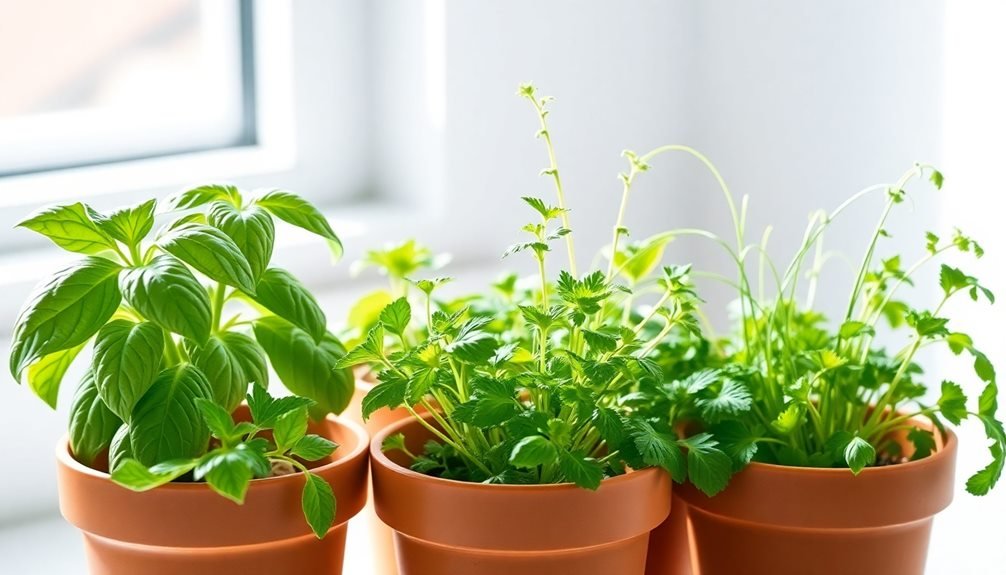
Indoor herb gardeners face several common challenges that can hinder plant growth and productivity. Even with the best indoor garden kits, you'll need to watch for signs of trouble and address issues quickly to maintain healthy herbs.
- Insufficient light exposure leading to leggy, weak stems and pale leaves – you'll need to adjust lighting or supplement with grow lights.
- Overwatering or poor drainage causing root rot and fungal growth – guarantee proper drainage holes and only water when soil feels dry.
- Temperature fluctuations from drafty windows or HVAC vents that stress plants – maintain consistent temperatures between 65-70°F.
- Pest infestations, particularly spider mites and aphids, that can quickly spread among indoor herbs – inspect leaves regularly and treat immediately.
- Nutrient deficiencies resulting in yellowing leaves or stunted growth – use appropriate fertilizer every 4-6 weeks.
If you notice any of these issues, don't panic. Most problems can be resolved by adjusting care routines and environment.
Keep a close eye on your plants' appearance and growth patterns, as early detection allows for quicker, more effective solutions. Regular monitoring and maintenance will help you overcome these common obstacles.
Harvesting Your Fresh Herbs
Throughout the growing season, you'll need to harvest your herbs regularly to encourage bushier growth and prevent flowering. Most herbs can be harvested once they reach 6-8 inches in height, but always leave at least 2/3 of the plant intact to guarantee continued growth. Cut stems just above a leaf node using clean, sharp scissors to prevent damage to the plant.
For leafy herbs like basil, cilantro, and mint, pinch off the top leaves and stems to promote branching. When harvesting parsley and dill, cut the outer stems at the base of the plant. With woody herbs such as rosemary, thyme, and sage, clip young, tender stems rather than woody ones for the best flavor.
Time your harvest for morning hours when the herbs' essential oils are most concentrated. Don't wash herbs until you're ready to use them, as excess moisture can lead to spoilage.
If you need to store fresh herbs, wrap them loosely in slightly damp paper towels and place them in a plastic bag in the refrigerator. Most herbs will stay fresh for up to a week when stored properly.
Indoor Garden Care Schedule
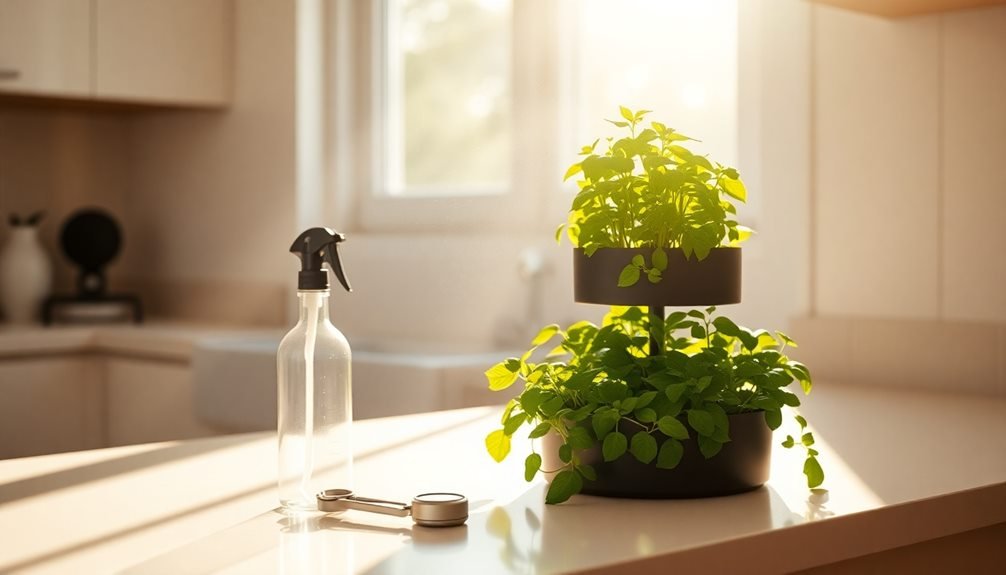
Maintaining a consistent care schedule assures your indoor herb garden thrives year-round. You'll need to set aside specific times each day and week to tend to your herbs, making certain they receive proper attention and care.
Create a simple daily and weekly routine that fits your schedule. In the morning, check soil moisture levels and water as needed. During midday, confirm your herbs receive adequate light, rotating containers if necessary to prevent uneven growth. In the evening, inspect for any signs of pest infestation or disease.
- Water herbs when the top inch of soil feels dry (typically every 2-3 days)
- Prune yellowing or dead leaves weekly to promote healthy growth
- Fertilize with diluted liquid fertilizer every 2-4 weeks during growing season
- Dust leaves monthly to maintain proper photosynthesis
- Check humidity levels twice weekly, misting if needed
Set reminders on your phone or calendar to stay consistent with your care routine. Keep a small journal to track watering, fertilizing, and pruning schedules. This helps you identify patterns in your herbs' growth and adjust care as needed.
Frequently Asked Questions
Can Indoor Herb Gardens Attract Insects or Pests to Other Houseplants?
Your indoor herbs can attract aphids, fungus gnats, and spider mites that might spread to nearby plants. But you'll minimize pest issues by maintaining good airflow, avoiding overwatering, and inspecting leaves regularly.
Do Herbs Grown Indoors Taste Different Than Those Grown Outside?
You'll notice indoor herbs can taste slightly milder than outdoor ones since they get less sunlight and stress. But with proper lighting and care, you can still grow flavorful herbs that'll enhance your cooking.
Will Growing Herbs Indoors Affect My Home's Humidity Levels?
Yes, your indoor herbs will slightly increase humidity levels as they release moisture through transpiration. You'll notice this most in small spaces, but it's usually beneficial since indoor air tends to be dry.
How Long Do Indoor Herb Garden Kits Typically Last Before Needing Replacement?
You'll typically get 4-6 months of use from most herb garden kits before needing replacements. However, if you maintain your plants well and harvest correctly, some herbs can last over a year indoors.
Can Indoor Herbs Cross-Pollinate and Affect Each Other's Flavors?
You don't need to worry about cross-pollination affecting herb flavors. While herbs can cross-pollinate, it only impacts future seeds, not the current plants' taste. Your existing herbs will maintain their distinct flavors.
In Summary
Starting your indoor herb garden is easier than you think. With the right starter kit and basic knowledge of growing conditions, you'll soon enjoy fresh herbs year-round. Remember to monitor your plants' light, water, and temperature needs, and don't be discouraged by early challenges. Stick to a regular maintenance schedule, and you'll be harvesting flavorful herbs from your own indoor garden in no time.

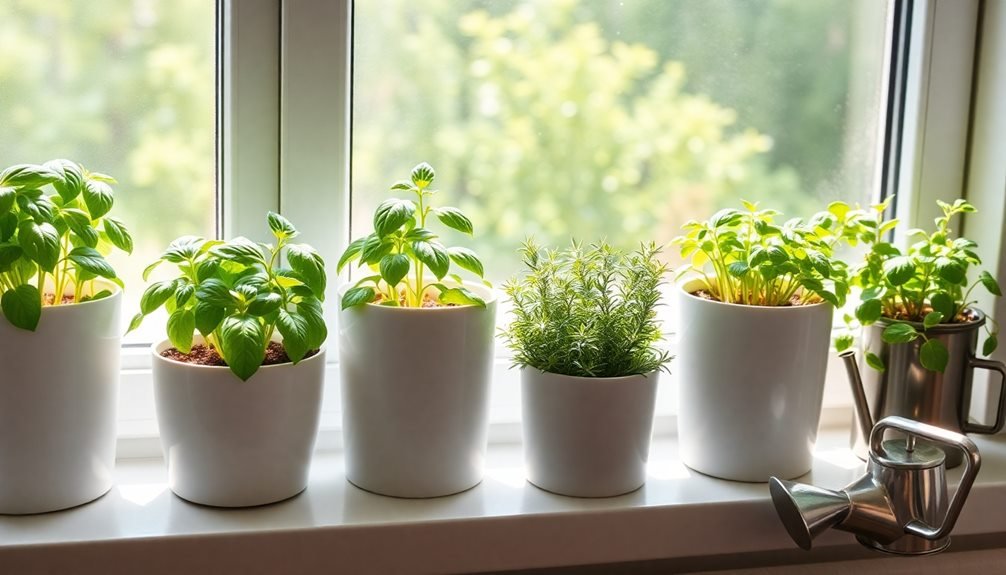



Leave a Reply